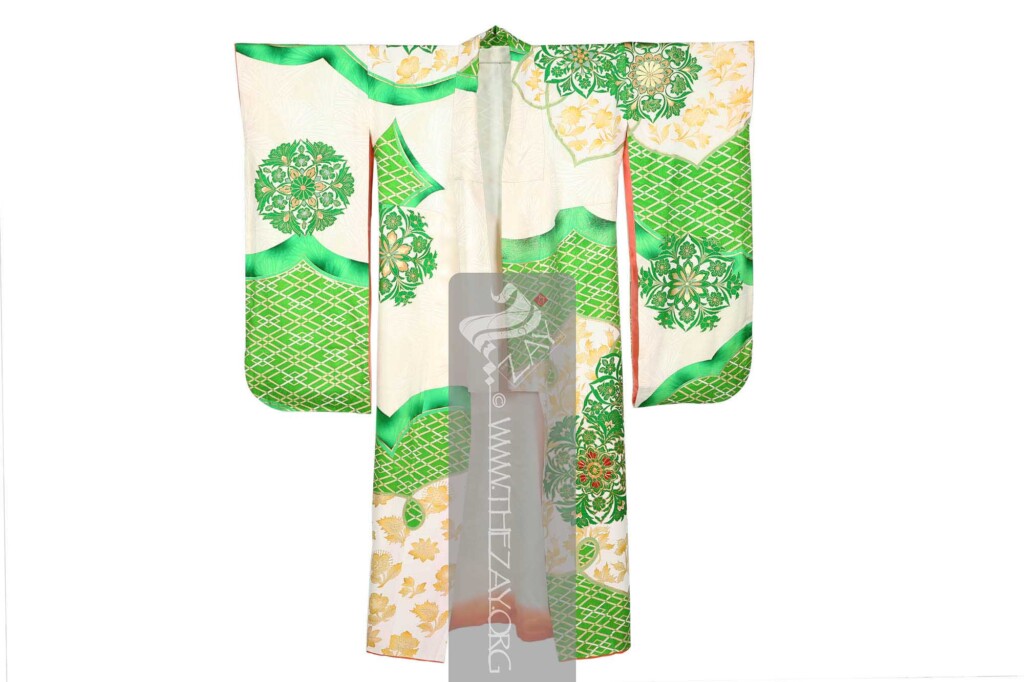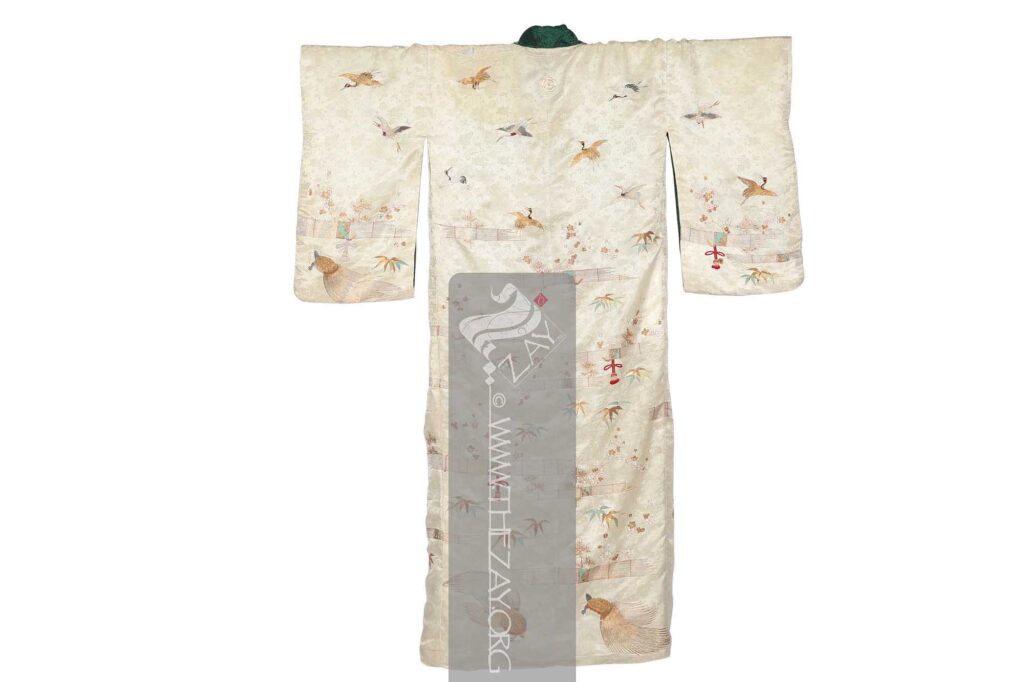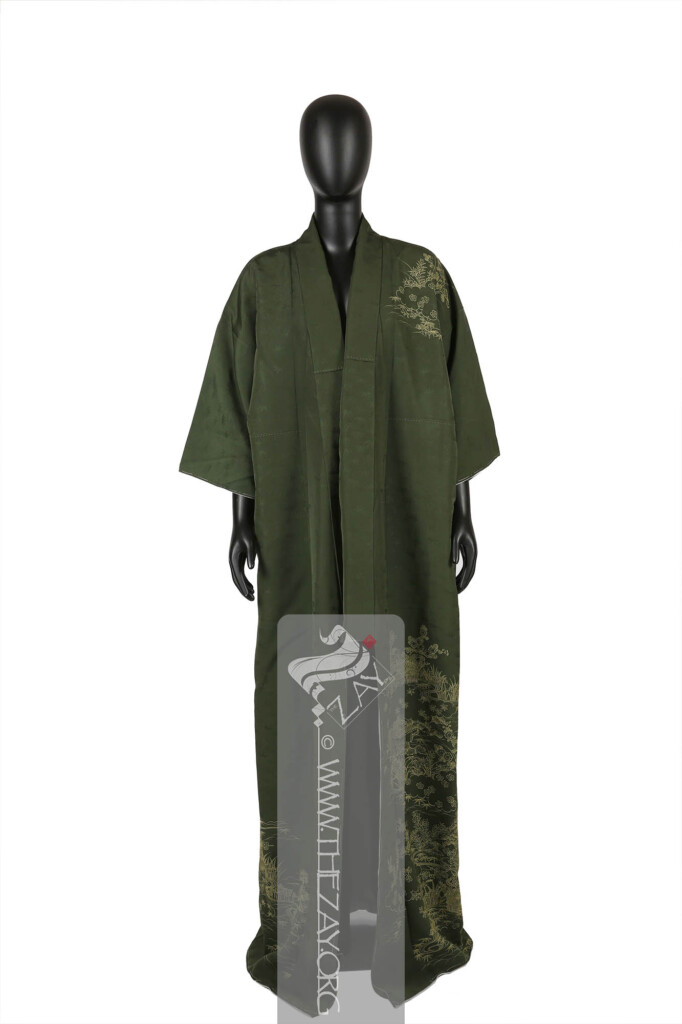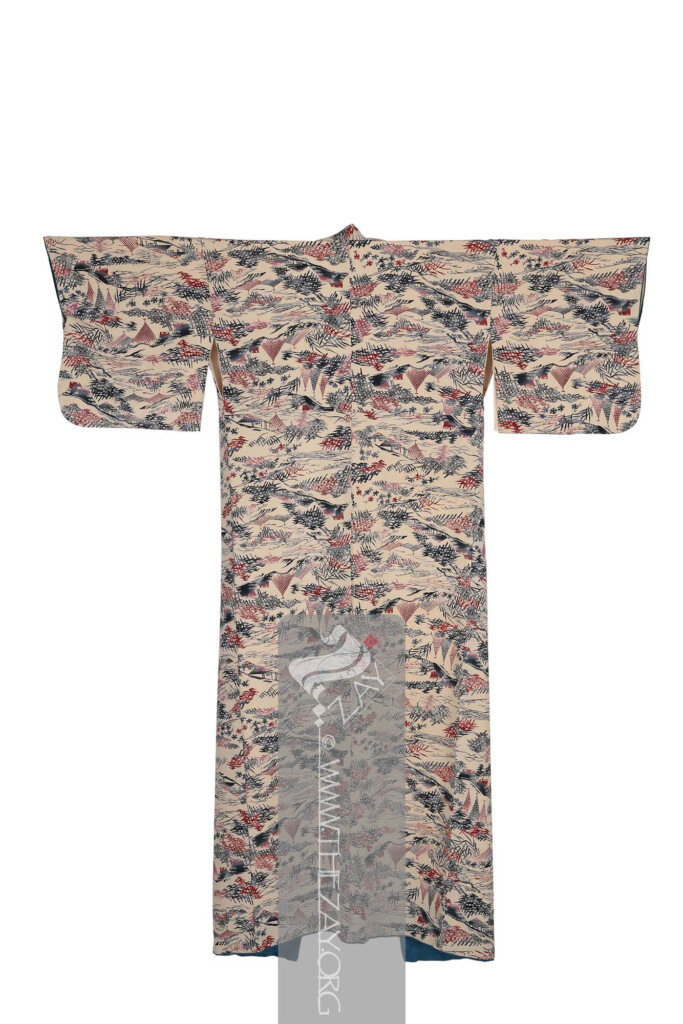Tracing back its roots and basic history to understand the Kimono and its cultural significance thus far, we have learnt how nature’s interference impeded cultural exchange between two nations, ultimately giving rise to an indigenous identity for the society residing in the Japanese archipelago. From the scarcity of imported textiles to the development of an independent architectural style, we’ve delved into the creation and evolution of the modern Kimono over the years. Looking ahead, we will explore the various kimonos still in use.
Furisode:

A furisode-style Kimono; “Printed silk women’s robe”, Japan; Acc. No: ZI2017.500480 ASIA; Source: The Zay Initiative, LINK
We begin with the (furisode) because it is typically the first type of Kimono that any Japanese woman first encounters. Worn by unmarried women and girls, these kimonos are characterised by their elaborately long sleeves. The term furisode quite literally translates to ‘swinging sleeves.’ They are often very elaborately embellished with bold motifs as well as vibrant colours and are usually reserved for formal occasions, such as the Coming of Age Day (Seiji no hi) or the traditional Japanese rite of passage ceremony famously called Shichi-Go-San.
With long, swinging sleeves, little girls as well as young unmarried ladies don their equivalent of ‘Sunday best’ in the form of a furisode. In fact, The Zay Initiative has several of them in its collection, including ZI 2017.500480 ASIA and ZI2017.500481 ASIA, among others. Interestingly, the furisode was the preferred formal attire for all unmarried women throughout the Edo Period (1603-1867).
Uchikake:

A uchikake-style Kimono; “Metal Embroidered women’s robe”, Japan; Acc. No: ZI2017.500487 ASIA; Source: The Zay Initiative, LINK
Uchikake-style kimonos were traditionally worn by Japanese women during the spring, autumn, or winter seasons. It is rather rare to come across an uchikake made of silk Gauze (Sha) fabric. However, it is becoming increasingly common for summer uchikake to make an appearance today, as brides prefer to wear it as part of their wedding ensemble.
It is designed to be one size longer than the Kimono worn underneath and features a thickly padded section called ‘fuki ‘along the hem. The purpose of the padding is to prevent the fine fabric of the garment from entangling at the ankles and the feet, as the uchikake is never tucked up and secured with a cord or a waistband. Additionally, a heavily padded hem creates the illusion of height, employing the enhanced perspective method.
Uchikakes are often adorned with intricate decorations, resembling painted pictures executed through embroidery, different dyeing techniques, impressing, or embroidering gold or silver foil on fabric – surihaku and nuihaku respectively.
The tradition of wearing uchikake can be traced back to the Muromachi period (1336-1392). During this period women of the affluent samurai families would layer uchikake over their home garments. In the Edo period, women in higher positions, such as the highest and middle-ranking ladies-in-waiting – ‘joro ‘and ‘churo’ – at the inner halls of the Edo Castle serving the Shogun’s wife, would wear the uchikake. Senior court ladies in the Imperial Palace and women from noble families also wore the uchikake as part of their daily attire. During the late Edo period, wealthy women from Kyoto, Osaka, and Tokyo began wearing uchikake for weddings and other ceremonial occasions.
Although traditionally worn by women of respectable society, uchikake also shares a close bond with the darker side of Japanese society. It has also served as a formal attire for the highest-ranking geisha ‘tayu’ in certain prominent geisha districts’ yukaku’ such as Yoshiwara in Tokyo and Shimabara in Kyoto where it is often referred to as ‘kake’ or ‘shikake.’
Houmongi:

A houmongi-style Kimono; “Printed silk women’s robe”, c. 19th century, Japan; Acc. No: ZI2020.500746 ASIA; Source: The Zay Initiative, LINK
A (houmongi) is a Kimono worn by both married and unmarried women for formal as well as semi-formal occasions. As evident from the above sample, a houmongi is almost always characterised by its elegant painting-style designs, often featuring landscapes, executed in such a way that it wraps itself around the wearer, especially on the back lower hem and the shoulders. This painting-style embellishment on a Kimono known as ‘eba‘ was quite famous during the Taisho Period (1912-1926).
Iromuji:
A iromuji is a plain Kimono usually in one solid colour other than black, worn by both married and unmarried women. Iromuji is typically worn for casual occasions. However, with an addition of a family crest, the formality of an iromuji can be elevated. Traditionally, patterns on an iromuji are avoided, as it is the preferred attire for a Japanese tea ceremony ‘sado’ as it prevents any clashes with the patterns on the tools used during the ceremony, which symbolise simplicity and modesty.
Furthermore, when paired with a black Kimono waistband ‘Obi’, it can be used as an informal mourning dress. If a light grey Obi with a width of 34 cm is added, an iromuji can also be worn as attire for a memorial service. In this way, an iromuji is a versatile Kimono suitable for various occasions, locations, and opportunities.
Komon

A komon-style Kimono; “Printed silk women’s robe”, c. 19th century, Japan; Acc. No: ZI2015.500747 ASIA; Source: The Zay Initiative, LINK
The Japanese Kimono known for its overall intricate patterns covering the entire garment, is usually the ‘komon.’ Unlike ‘houmongi’ and ‘tsukesage,’ which feature strategically placed patterns, Komon patterns are applied without any specific direction or orientation. Due to this characteristic, Komon is not typically worn as formal attire. Komon is generally worn by both married and unmarried women.
In modern usage, the term ‘komon’ generally refers to any Kimono with a pattern that lacks a particular direction, regardless of the pattern’s size or density. There are various types of komon, such as ‘Tokyo-some-komon,’ ‘Kyo-komon,’ and ‘Kaga-komon,’ recognised and named after the main embellishment techniques and styles of komon.
Tokyo-some Komon originated from the dyeing techniques used for embellishing ceremonial samurai attires (kamishimo) during the Edo period. It is currently classified into two sub types: ‘Edo-komon’ and ‘Tokyo- oshare-komon.’
On June 2, 1976, Edo Komon was officially recognised as one of the traditional Japanese crafts. Originated from the patterns found on ceremonial kamishimo, these patterns were the result of feuds and competition between high-ranking feudal families pining for luxurious designs. Feuds over these patterns within the samurai families went so far that sumptuary regulations had to be imposed during the Edo period. Adhering to such restrictions to achieve the appearance of a solid colour and uniformity from the distance, small patterns were created, resulting in a highly skilled dyeing technique. Each feudal or shogun clan – Tokugawa, Maeda, Shimazu and Nabeshima – had a designated pattern.
Such practices within the shogun society inspired the masses, who began imitating komon and created patterns inspired by everyday objects, turning them into fashionable designs.
Generally characterised by the use of paper patterns for dyeing, Edo-komon were embellished using paper patterns manufactured in Ise, as such patterns were not made in Edo. Today the scarcity of successors within the paper pattern artisan’s community has become a great deterrent.
Although considered casual attire, an Edo-komon generally commands a higher degree of respect due to its association with Japan’s feudal history. Depending on the design it exhibits, an Edo-komon can thus be suitable for semi formal occasions too if paired with a family crest.
The term Edo-komon was specifically coined to differentiate it from Kyo-komon in 1955.
Tokyo-oshare-komon, on the other hand, incorporates modern patterns and dyes while employing the techniques of traditional Edo-komon. In short, it is the modern version of the Edo-komon.
Although there is long history of manufacturing various types of Kimono using stencil dyeing techniques in Kyoto, it was not until the Meiji Era (1868-1912) that komon production, fully utilising stencil dyeing, flourished. Komon Kimono featuring a fusion of vibrant designs from ‘yuzen’ printing and stencil dyeing is generally referred to as Kyo-komon. Unlike the visual uniformity unique to the Edo-komon, Kyo-komon features multiple colours. As a result, its individual patterns are larger, giving it a more splendid appearance, with a more defined and concrete design rather than an abstract one.
Influenced by both Kyo-komon as well as Edo-komon, new designs began to be produced in Ishikawa Prefecture using the yuzen technique unique to the city of Kaga. These komon are identified as Kaga-komon.
The world of kimonos offers a colorful tableau of diverse styles, each possessing its own unique charm and reflecting Japanese culture and craftsmanship. From the versatile ‘iromuji’ to the intricate ‘komon,’ these garments showcase both deliberate pattern placement in ‘houmongi’ and ‘tsukesage,’ as well as the random beauty of ‘komon.’ Meanwhile, ‘Edo-komon’ and ‘Tokyo-oshare-komon’ carry historical significance, contrasting with the vibrant hues of ‘Kyo-komon’ and the innovative spirit of ‘Kaga-komon.’ Beyond their aesthetics, kimonos carry stories of samurai rivalries, fashion evolution, and cultural transitions, bridging tradition and modernity. They encapsulate centuries of artistry, tradition, and innovation in one garment, offering a glimpse into Japan’s evolving cultural landscape. As we delve deeper into the world of kimonos, the next articles will explore various Kimono types, the history of the Obi, Japanese family crests, and techniques like Shibori, Katazome, and Yuzen.

